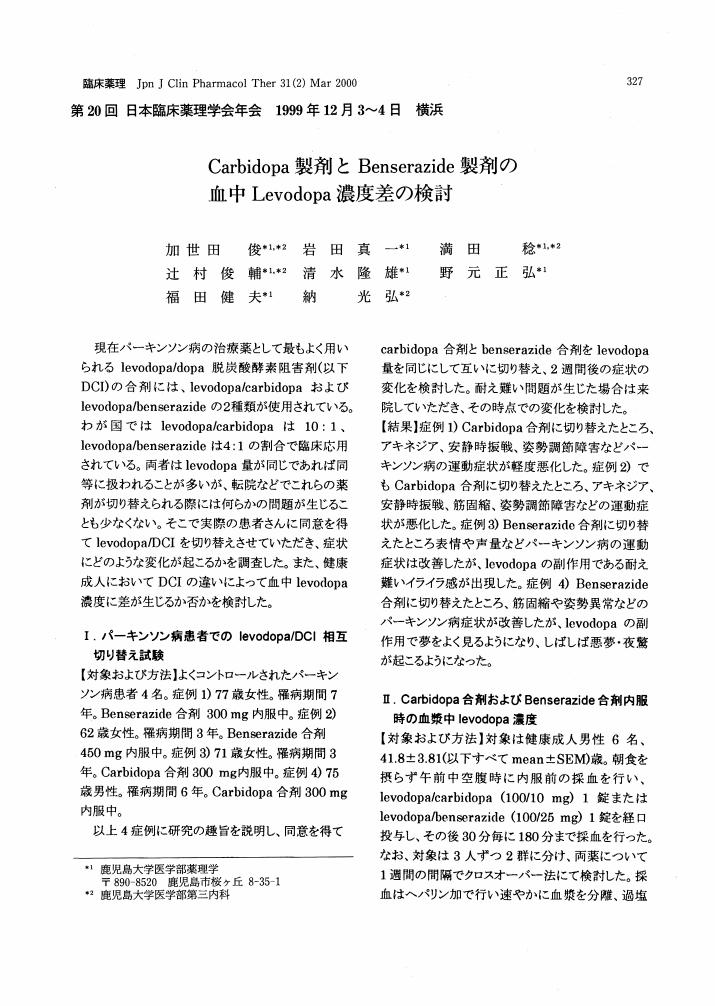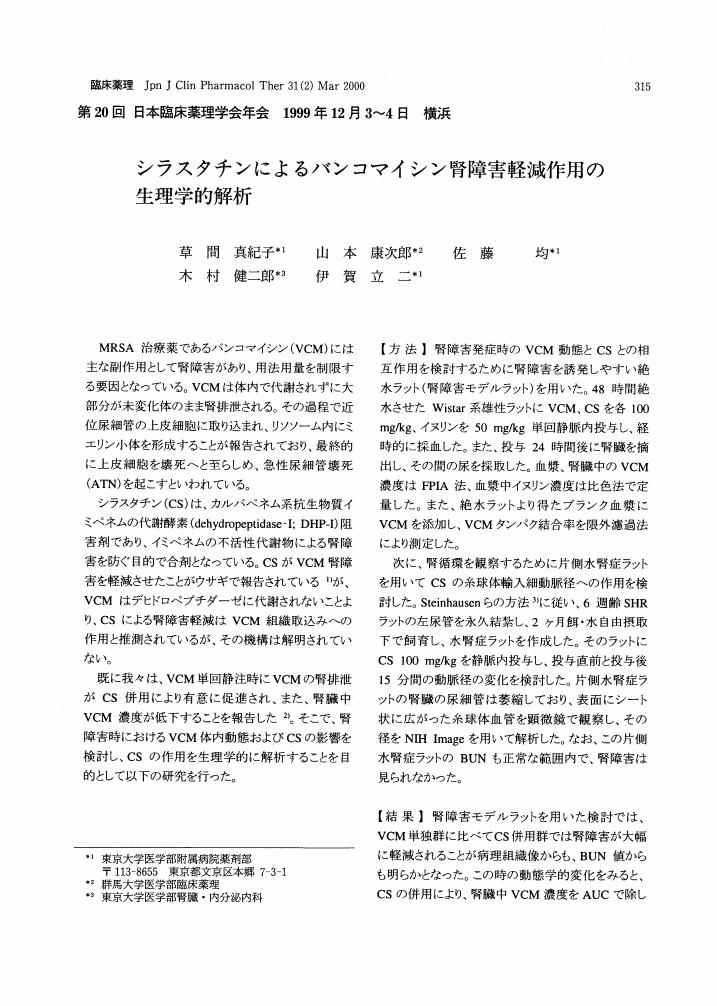1 0 0 0 OA 座長のまとめ
- 著者
- 梅村 和夫 和田 孝一郎
- 出版者
- 一般社団法人 日本臨床薬理学会
- 雑誌
- 臨床薬理 (ISSN:03881601)
- 巻号頁・発行日
- vol.42, no.2, pp.63-64, 2011 (Released:2011-06-30)
1 0 0 0 日本人健康成人男性におけるMSG203錠およびパキシル^【○!R】錠(パロキセチン塩酸塩水和物)の単回経口投与後の生物学的同等性の検討 : CYP2D6 Genotype による詳細比較
- 著者
- 内田 直樹 小林 秀行 戸嶋 洋和 三邉 武彦 小林 真一
- 出版者
- The Japanese Society of Clinical Pharmacology and Therapeutics
- 雑誌
- 臨床薬理 = Japanese journal of clinical pharmacology (ISSN:03881601)
- 巻号頁・発行日
- vol.43, no.2, pp.57-64, 2012-03-31
- 参考文献数
- 13
MSG203 was developed by Meiji Seika Pharma Co., Ltd. as a generic drug of paroxetine hydrochloride hydrate (Paxil<sup>®</sup> Tablets). Paroxetine is mainly metabolized by CYP2D6.Therefore, in addition to the evaluation of bioequivalence between MSG203 and Paxil<sup>®</sup>, the effects of CYP2D6 polymorphism on the pharmacokinetic (PK) parameters of plasma paroxetine were also investigated.<BR>Ninety-six Japanese healthy subjects aged 20-35 years participated in the study. The study was performed in 3 different groups: MSG5 group compared 2 tablets of MSG203 5 mg versus 1 tablet of Paxil<sup>®</sup> 10 mg; MSG10 group compared 1 tablet of MSG203 10 mg versus 1 tablet of Paxil<sup>®</sup> 10 mg; and MSG20 group compared 1 tablet of MSG203 20 mg versus 1 tablet of Paxil<sup>®</sup> 20 mg. Bioequivalence between MSG203 and Paxil<sup>®</sup> was confirmed in all three groups. The safety profiles of both drugs were also similar. The PK parameters after a single oral dose of MSG203 20 mg in subjects with different CYP2D6 phenotypes were as follows. Mean C<sub>max</sub> (ng/mL) of paroxetine was 0.78 in ultra-rapid metabolizers (UM; n=1), 5.82 in extensive metabolizers (EM; n=24), and, 18.60 in intermediate metabolizers (IM; n=4). Mean AUC <sub>t</sub> (ng•h/mL) was 7.93 in UM, 88.52 in EM, and 495.61 in IM. Similar PK profiles in these phenotypes were confirmed after a single oral dose of Paxil<sup>®</sup>.<BR>In this study, plasma concentrations of paroxetine were very low because of the high clearance profile in UM subjects. Generally, inadequate treatment would occur in patients with the UM phenotype of CYPs. However, information on the PK profiles in different CYP phenotypes is insufficient. Evaluation of the PK profiles of drugs in different CYP phenotypes provides valuable information for clinical use of drugs that are metabolized by polymorphic enzymes.
1 0 0 0 OA 4.TGN1412事件の倫理的問題点:薬事規制による被験者保護の限界
- 著者
- 栗原 千絵子
- 出版者
- 一般社団法人 日本臨床薬理学会
- 雑誌
- 臨床薬理 (ISSN:03881601)
- 巻号頁・発行日
- vol.39, no.4, pp.113S-114S, 2008 (Released:2009-02-04)
- 参考文献数
- 8
1 0 0 0 OA 累積二項確率の能率的算出法
- 著者
- 栗谷 典量
- 出版者
- 一般社団法人 日本臨床薬理学会
- 雑誌
- 臨床薬理 (ISSN:03881601)
- 巻号頁・発行日
- vol.10, no.1, pp.69-70, 1979-03-30 (Released:2010-06-28)
1 0 0 0 アルコールとタバコ, カフェイン飲料との相互関係
- 著者
- 羽賀 道信 清野 忠紀
- 出版者
- The Japanese Society of Clinical Pharmacology and Therapeutics
- 雑誌
- 臨床薬理 (ISSN:03881601)
- 巻号頁・発行日
- vol.8, no.3, pp.365-370, 1977
- 著者
- 水嶋 雅子 横田 祥 石川 岳彦 華岡 由香里 〓野 繁雄 劔物 修
- 出版者
- The Japanese Society of Clinical Pharmacology and Therapeutics
- 雑誌
- 臨床薬理 (ISSN:03881601)
- 巻号頁・発行日
- vol.20, no.4, pp.777-781, 1989
Effects of pre-operative administration of ranitidine on pH and volume of gastric juicewere evaluated in 54 children (mean age: 5.4±1.0 yr) who underwent elective surgeryunder general anesthesia. Simultaneously, bromazepam suppository was evaluated as a premedicationagent for pediatric patients. Patients were randomly divided into four groups, and premedication agents were given 2 hr prior to induction of anesthesia. Patients ingroup A received diazepam syrup (0.5 mg/kg P. o.) ahd those in group B received bromazepamsuppository (3 mg). Patients in groups C and D received ranitidine (1 mg or2 mg/kg i. m.) together with bromazepam suppository (3 mg). Following induction ofanesthesia, a gastric tube (10 Fr. or 12 Fr.) was passed and stomach contents were collectedand analyzed for volume and pH, which was repeated every hr until the end ofthe operation. The gastric pH at the induction of anesthesia was observed to be 2.5 orless in 70% of the patients of groups A and B, 13% of group C, and O% of group D.The volume of gastric contents was less than 0.4 ml/kg in 87% of ranitidine-treatedpatiehts (groups C and D), in 29% of group A, ahd in 60% of group B. It was thenconcluded that pre-operative administration of ranitidine caused a significant reduction ofboth acidity and volume of gastric contents, which will contribute to preventing or reducingaspiration pneumonitis during general anesthesia. Plasma ranitidine concentrationsmeasured by high-performance liquid chromatography revealed 228±32 ng/ml in group Cand 487±59 ng/ml in group D at the induction.of anesthesia. Sedation at the inductionof anesthesia was evaluated utilizing our original pediatric premedication score, whichconsists of 3 check points: quietness (very good, 3 ; good, 2 ; fair, 1 ; bad, 0); crying (no, 2 ; a little, 1 ; yes, 0); and i. v. root (under local anesthesia, 1 ; following induction ofanesthesia, 0). The averaged scores were 4.5±0.4 in group A, 4.2±1.9 in group B, 4.1±0.6 in group C, and 4.8±0.5 in group D, respectively. There was no significantdifference in the score in 4 groups. A plasma bromazepam level was 414±49 ng/ml at theinduction of anesthesia. Our results showed that bromazepam suppository is as effectiveas diazepam syrup for premedication in children.
1 0 0 0 シラザプリル初回1mg/日投与の有用性および安全性に関する検討
1 0 0 0 OA Carbidopa製剤とBenserazide製剤の血中Levodopa濃度差の検討
1 0 0 0 OA 麻痺筋に対する脱分極性薬剤の作用
- 著者
- 高橋 俊一 北山 隆 岡本 康朗 高尾 弘 舘田 武志 高橋 敬蔵
- 出版者
- 一般社団法人 日本臨床薬理学会
- 雑誌
- 臨床薬理 (ISSN:03881601)
- 巻号頁・発行日
- vol.19, no.1, pp.275-276, 1988-03-31 (Released:2010-06-28)
- 参考文献数
- 4
- 著者
- 景山 孝正 大野 文俊 安田 行寛 新藤 恭司 三谷 鳴夫 丸伝 章 赤沢 明
- 出版者
- 一般社団法人 日本臨床薬理学会
- 雑誌
- 臨床薬理 (ISSN:03881601)
- 巻号頁・発行日
- vol.10, no.4, pp.525-533, 1979
- 被引用文献数
- 1
The biological fate of suxibuzone (SB), a new non-steroidal anti-inflammatory agent, was studied in healthy male volunteers with single oral doses and compared with that of phenylbutazone (PB) by a cross-over test, with the following results:<BR>1) PB, oxyphenbutazone (Oxy-PB), and γ-hydroxy-phenylbutazone (γ-Hydroxy-PB) were identified in plasma after oral administration of SB. Moreover these metabolites, their glucuronides, SB-glucuronide, 4-hydroxymethyl-phenylbutazone (4-HM-PB)-glucuronide, and <I>p</I>, γ-dihydroxy-phenylbutazone (<I>p</I>, γ-DH-PB) were found in urine.<BR>2) Peak plasma concentration of the metabolites was obtained 4 hrs after a single oral dose of 426 mg of SB when the concentration of PB, the main metaboliteof SB, was 36μg/ml, much the same as the corresponding level in the volunteers receiving PB. On the other hand, there was no difference between volunteers receiving SB and PB interms of the concentration of Oxy-PB. But the concentration of γ-Hydroxy-PB was higher after oral SB than after oral PB.<BR>3) Urinary excretion of the metabolites was about 8% of the administered dose up to 16 8hrs after oral doses of SB or PB, but in the period shortly after oral doses of SB, Oxy-PB-glucuronide and γ-Hydroxy-PB were excreted to ag reater extent than after oral doses of PB.<BR>4) From these results in the plasma and urine after oral doses of SB, it was found that SB may be characterized as a prodrug of PB.<BR>5) During the experiment, no side effects or abnormalities were observed in the medical examination and laboratory test except for a slight decrease in the uric acid level in plasma.
1 0 0 0 OA 非線形混合効果モデルによる臨床試験データ解析における注意点
- 著者
- 竹内 正弘 矢船 明史 成川 衛
- 出版者
- 日本臨床薬理学会
- 雑誌
- 臨床薬理 (ISSN:03881601)
- 巻号頁・発行日
- vol.31, no.5, pp.659-665, 2000-09-30 (Released:2010-06-28)
- 参考文献数
- 26
Nonlinear mixed effects models are often used for the analysis of repeated measure ments in clinical trials. A typical example is population pharmacokinetic analysis. Due to the statistical complexity, careful attention must be paid to some statistical issues in order to obtain reliable and robust results. This paper provides a description of the notes on the use of nonlinear mixed effects models for the analysis of repeated measurements in clinical trials. Three main issues are discussed in this paper: 1) a first-order lineariza tion, 2) a missing data, and 3) a measurement error.
1 0 0 0 OA 1.創薬育薬医療チームと創薬育薬医療スタッフというコンセプトの重要性
- 著者
- 中野 重行
- 出版者
- 一般社団法人 日本臨床薬理学会
- 雑誌
- 臨床薬理 (ISSN:03881601)
- 巻号頁・発行日
- vol.39, no.4, pp.75S-76S, 2008 (Released:2009-02-04)
- 参考文献数
- 2
- 被引用文献数
- 3 3
1 0 0 0 OA 老年者におけるbenzodiazepine系抗不安薬の薬物動態
1 0 0 0 <b>「臨床薬理」誌へのアクセス統計レポート(1)</b>
- 著者
- 越前 宏俊
- 出版者
- The Japanese Society of Clinical Pharmacology and Therapeutics
- 雑誌
- 臨床薬理 (ISSN:03881601)
- 巻号頁・発行日
- vol.43, no.4, pp.235-239, 2012
1 0 0 0 OA 2.薬物トランスポーターを介した相互作用
- 著者
- 増田 智先
- 出版者
- 一般社団法人 日本臨床薬理学会
- 雑誌
- 臨床薬理 (ISSN:03881601)
- 巻号頁・発行日
- vol.44, no.6, pp.473-479, 2013-11-30 (Released:2013-12-20)
1 0 0 0 OA 薬害論
- 著者
- 砂原 茂一
- 出版者
- 一般社団法人 日本臨床薬理学会
- 雑誌
- 臨床薬理 (ISSN:03881601)
- 巻号頁・発行日
- vol.8, no.3, pp.331-337, 1977-09-30 (Released:2010-06-28)
- 参考文献数
- 5
1 0 0 0 OA シラスタチンによるバンコマイシン腎障害軽減作用の生理学的解析
- 著者
- 草間 真紀子 山本 康次郎 佐藤 均 木村 健二郎 伊賀 立二
- 出版者
- 一般社団法人 日本臨床薬理学会
- 雑誌
- 臨床薬理 (ISSN:03881601)
- 巻号頁・発行日
- vol.31, no.2, pp.315-316, 2000-03-31 (Released:2010-06-28)
- 参考文献数
- 3
1 0 0 0 OA シリーズ[2] クレーマー対処例:水商売らしい女性患者
- 著者
- 三輪 亮寿
- 出版者
- 一般社団法人 日本臨床薬理学会
- 雑誌
- 臨床薬理 (ISSN:03881601)
- 巻号頁・発行日
- vol.40, no.6, pp.311-314, 2009 (Released:2009-12-25)
1 0 0 0 OA 鎮静性抗ヒスタミン薬が自動車運転シミュレーション中の局所脳血流量変化に及ぼす影響
- 著者
- 櫻田 幽美子 田代 学 望月 秀紀 堀川 悦夫 谷内 一彦
- 出版者
- 一般社団法人 日本臨床薬理学会
- 雑誌
- 臨床薬理 (ISSN:03881601)
- 巻号頁・発行日
- vol.34, no.2, pp.245S-246S, 2003-03-31 (Released:2010-06-28)
- 参考文献数
- 2












